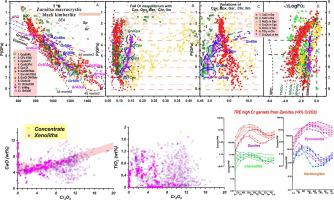Journal of Asian Earth Sciences ( IF 2.7 ) Pub Date : 2021-03-24 , DOI: 10.1016/j.jseaes.2021.104756 Igor Ashchepkov , Nikolay Medvedev , Alexander Ivanov , Nikolay Vladykin , Theodoros Ntaflos , Hilary Downes , Anatoliy Saprykin , Alxander Tolstov , Mikhail Vavilov , Gleb Shmarov

|
Zarnitsa kimberlite pipe in Central Yakutia contains pyrope garnets with Cr2O3 ranging from 9 to 19.3 wt% derived from the asthenospheric mantle. They show mostly S-shaped, inflected rare earth element (REE) patterns for dunitic and harzburgitic, lherzolitic and harzburgitic varieties and all are rich in high field strength elements (HFSE) due to reaction with protokimberlite melts. Lithospheric garnets (<9 wt% Cr2O3) show a similar division into four groups but have more symmetric trace element patterns. Cr-diopsides suggest reactions with hydrous alkaline, protokimberlitic and primary (hydrous) partial melts. Cr-diopsides of metasomatic origin have inclined REE patterns and high LILE, U, Th and Zr concentrations. Four groups in REE of Ti-rich Cr-diopsides, and augites have asymmetric bell-like REE patterns and are HFSE-rich. Mg-ilmenites low in REE were formed within dunite conduits. Ilmenite derived from differentiated melts have inclined REE patterns with LREE ~ 100 × chondrite levels. Thermobarometry for dunites shows a 34 mWm−2 geotherm with a HT branch (>50 mWm−2) at 6–9 GPa, and a stepped HT geotherm with heated pyroxenite lenses at four levels from 6.5 to 3.5 GPa. Parental melts calculated with KDs suggest that augites and high-Cr garnets in the lithosphere base reacted with essentially carbonatitic melts while garnets from lower pressure show subduction peaks in U, Ba and Pb. The roots of the Zarnitsa pipe served to transfer large portions of deep (>9 GPa) protokimberlite melts to the lithosphere. Smaller diamonds were dissolved due to the elevated oxidation state but in peripheral zones large diamonds could grow.
中文翻译:

俄罗斯西伯利亚克拉通Zarnitsa金伯利岩管的深地幔根:与地幔熔体的多级多压相互作用的证据
雅库特中部的Zarnitsa金伯利岩管含有从软流圈地幔中提取的Cr 2 O 3含量为9至19.3 wt%的焦石榴石。它们显示了D型和哈茨堡型,叶沸石和哈茨堡型的大部分S型弯曲稀土元素(REE)模式,并且由于与原金伯利岩熔体的反应而均富含高场强元素(HFSE)。岩石圈石榴石(<9 wt%Cr 2 O 3)显示相似的划分为四个组,但具有更多对称的痕量元素图案。Cr-二叠氮化物表明与含水碱性,原金伯利岩的和初级(含水)部分熔体发生反应。交代成因的二叠氮化铬具有倾斜的REE模式和较高的LILE,U,Th和Zr浓度。富钛的Cr-二叠氮化物和闪锌矿的REE中有四组具有不对称的钟状REE模式,并且富含HFSE。REE含量低的镁钛铁矿在榴辉岩管道中形成。来自不同熔体的钛铁矿具有倾斜的REE模式,其LREE〜100×球粒晶水平。dunites的热压法显示34 mWm -2地热,带有HT分支(> 50 mWm -2)在6–9 GPa的温度范围内,以及带有6.5至3.5 GPa的四个水平的加热的辉石岩晶状体的阶梯式HT地热仪。用KDs计算的母体熔体表明,岩石圈底部的辉石和高Cr石榴石与本质上的碳酸盐熔体发生了反应,而来自低压的石榴石则在U,Ba和Pb中出现了俯冲峰。Zarnitsa管道的根部用于将大部分深层(> 9 GPa)的原金伯利岩熔体转移到岩石圈。较小的钻石由于升高的氧化态而溶解,但在外围区域可能会长出较大的钻石。











































 京公网安备 11010802027423号
京公网安备 11010802027423号